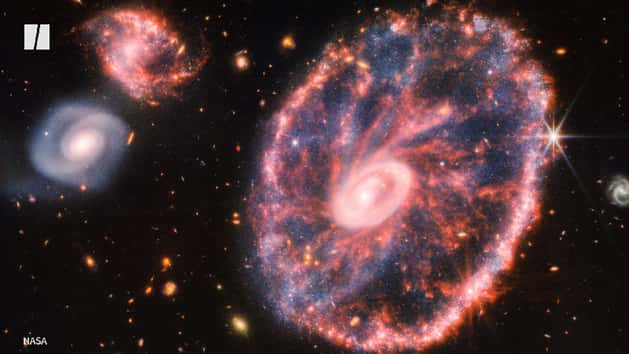


A distant world unlike any planet in our own Solar System could potentially be “teeming” with life, according to a groundbreaking new study.
“We found the strongest evidence to date of possible biological activity on an exoplanet,” University of Cambridge Prof. Nikku Madhusudhan said in a video announcement.
Madhusudhan and his team used data from the James Webb Space Telescope to find chemical signatures they believe suggest life on K2-18b.
That’s a planet about two and a half times the size of Earth, and 8.6 times more massive, that sits in the habitable “Goldilocks Zone” of a dwarf star about 120 light years away.
They looked specifically for something called DMS, or dimethyl sulfide, a chemical that on Earth is produced solely by living organisms such as algae.
It’s so uniquely produced by life that scientists have theorized that checking other planets for its “biosignature” could be the key to finding life outside of our own planet.
And that’s what they’ve found, as well as another potential marker of life called DMDS, and in levels thousands of times higher than what’s seen on Earth, according to research published in The Astrophysical Journal Letters.
“Given everything we know about this planet, a Hycean world with an ocean that is teeming with life is the scenario that best fits the data we have,” Madhusudhan said in a press release from Cambridge.
But he also called for caution, saying more research is needed.
“We should remain open-minded and get more observations so we can repeat this signal. That’s the hallmark of science, the repeatability and increase in robustness till we get, till we are really, really satisfied,” he said in his video release. “We are not there yet.”
Story continues below image.

Madhusudhan said that while DMS and DMDS are believed to be markers of life, there’s always the possibility that they might exist on worlds such as K2-18b via processes not yet known to us.
Other researchers also said it will take time and more study before anyone can say if this planet is indeed a candidate for life outside of Earth.
“We should be cautious. I want that to be front and center,” Måns Holmberg of the Space Telescope Science Institute, who was part of the group announcing the findings, told NPR. “Any claim of life on another planet requires a lot of justification, and I don’t think we’re there yet.”
Stephen Schmidt, a planetary scientist at Johns Hopkins University, told the New York Times the new study offered a “hint.”
“But we cannot conclude it’s habitable yet,” he said.
Christopher Glein, principal scientist at the Space Science Division of the Southwest Research Institute in Texas, told Reuters the new study makes the planet a “tantalizing world.”
“Yet, we must be very careful to test the data as thoroughly as possible,” he told the news agency. “I look forward to seeing additional, independent work on the data analysis starting as soon as next week.”
Another scientist is even more skeptical: Dr Nicolas Wogan of the NASA Ames Research Center has published a paper suggesting the planet has no habitable surface at all but is rather a mini gas giant, the BBC noted.
Madhusudhan is planning to get to the bottom of it.
“This is the strongest evidence yet there is possibly life out there,” he told the BBC. “I can realistically say that we can confirm this signal within one to two years.”

